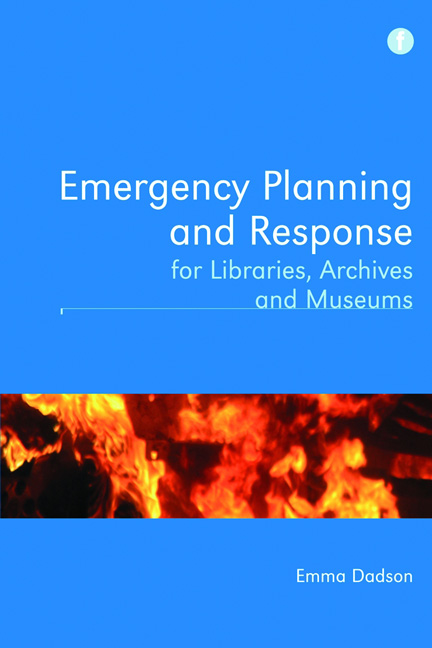Book contents
- Frontmatter
- Contents
- Foreword
- Preface
- Acknowledgements
- 1 Introduction
- 2 Case studies
- 3 Roles and responsibilities
- 4 Incident control
- 5 Planning the recovery operation
- 6 Collections salvage
- 7 Supplementary content
- 8 Dealing with the building
- 9 Business continuity
- 10 Ensuring the plan's efficacy
- 11 Conclusion
- Bibliography and references
- Index
- Frontmatter
- Contents
- Foreword
- Preface
- Acknowledgements
- 1 Introduction
- 2 Case studies
- 3 Roles and responsibilities
- 4 Incident control
- 5 Planning the recovery operation
- 6 Collections salvage
- 7 Supplementary content
- 8 Dealing with the building
- 9 Business continuity
- 10 Ensuring the plan's efficacy
- 11 Conclusion
- Bibliography and references
- Index
Summary
This chapter will provide guidance on what additional information may be required as a reference tool for an effective emergency response. In most plans, such information is usually located in appendices, and a list of suggested appendices was given in Chapter 1. They are discussed in order, although some are merely listed and the crossreference given to where their content and design is explained in other chapters. Others are discussed in more detail. Although this section undoubtedly adds to the workload of plan composition and the overall size of the disaster plan, the appendices (sometimes referred to as annexes) are potentially invaluable if your plan is ever implemented.
Although you may have floor plans, supplier account numbers and contact details for depositors and stakeholders in your filing cabinet, this is not very helpful if you are denied access to your office in an emergency for safety reasons. The appendices function as a backup so that if the situation is too big for you to manage internally, or if the scale of the incident is causing an element of panic, which makes you question things you would ordinarily recall without question (e.g. the location of and process for isolating stopvalves), your appendices will be there as a bespoke emergency reference tool. In most smallscale incidents, for example involving a small leak and not much damage, the appendices will only receive cursory attention as the incident and its consequences should be relatively manageable. However, appendices are of immense importance when dealing with incidents that are bigger in scale and cannot obviously be managed without going to external agencies.
Personnel contact lists
When a large volume of material has been damaged, particularly when the nature of damage is water, the salvage operation will be enhanced significantly by involving large numbers of staff or volunteers to assist the recovery efforts to move quickly. Ability to corral large numbers of people to assist in this process is therefore crucial. Consider a task that takes a team of two people 100 hours to complete, or 10–12 days. This same activity, presuming the same work rate and no constraints in terms of access or resources, can be tackled in just 50 hours by four people, or 25 hours by eight people or 12.5 hours by sixteen individuals.
- Type
- Chapter
- Information
- Publisher: FacetPrint publication year: 2012



